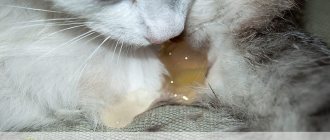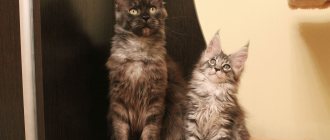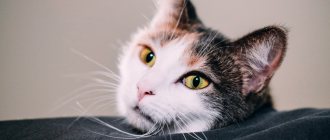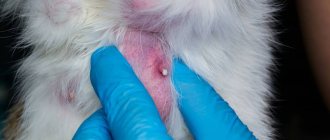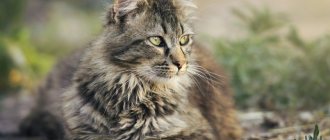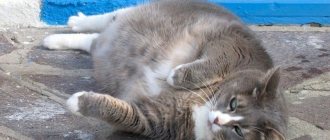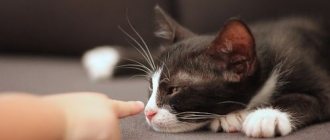Do cats menstruate?
In a word...no.
Of course they have a reproductive cycle. But this will not be associated with bleeding. This will involve constant howling, rolling, urinating, and the cat constantly raising his butt in the air with his tail up, but a cat's heat cycle does not include bleeding.
She may be noisy and a little annoying, but at least there's no blood to clean up!
© shutterstock
What is a heat cycle?
The heat cycle is a more accurate way to describe a cat's reproductive cycle. This usually starts when she reaches six months of age, but depending on the breed it can be anywhere from four months to a year. During this time, the cat will be able to mate, ovulate and give birth to kittens.
She can be bred at any time in this cycle and may even have a litter of multiple males. Estrus can last from one day to a week. It will be another week or two before she goes into heat again. Environmental factors can influence the length of the breeding cycle.
Cats are ovulatory inducible, meaning that she will continually come and go until she is bred. If you don't want kittens, it's best to have her spayed.
Deviations from the norm
Prolonged heat
It happens that a pet is in heat for more than 2 weeks. This is called prolonged heat. This means an increase in the stages of estrus. There is a protracted proestrus, a protracted estrus and a protracted diestrus.
Symptoms of prolonged proestrus:
- The cat won't let the cat near.
- Discharge from the genitals continues for more than two weeks.
Symptoms of prolonged estrus:
- Estrus lasts more than 2-3 weeks, but fertilization does not occur.
Symptoms of prolonged diestrus:
- Mucous discharge from the female genitals does not stop for 21 days.
Anaphrodisia
Another deviation is the complete absence of estrus symptoms (anaphrodisia).
Symptoms:
- Lengthening of the intervals between estrus in a mature cat or its complete absence.
- Delayed puberty in a young individual.
If any of these deviations occur, be sure to show the cat to a specialist. He will prescribe competent treatment.
False pregnancy
It happens that fertilization does not occur. The female develops a so-called false pregnancy. This is a psychological condition during which the cat experiences all the signs of a non-existent pregnancy. The cause of the disease may lie in stressful situations, mating with an unproductive male, or a breed predisposition, for example, in sphinxes.
This condition lasts for 1-3 weeks. It is difficult to distinguish it from ordinary pregnancy.
Symptoms of false pregnancy:
- abdominal enlargement;
- swelling of the mammary glands;
- secretion of milk;
- increased appetite;
- constant thirst.
The pet's behavior also changes. She is looking for a secluded dark place, trying to arrange a bed for herself.
Also, your pet may begin to carry various soft toys in her teeth, mistaking them for her offspring.
This condition is dangerous because the cat can develop purulent mastitis.
Only a veterinarian can confirm whether it is a false pregnancy or a real one after examination. He will prescribe sedatives to stop lactation.
Empty heat
This is an estrus that did not result in the pet becoming pregnant. It can lead to many complications: ovarian cysts, inflammation and even cancer. Therefore, if you do not plan to mate your cat, it is best to have her spayed. You can read about all the nuances of this operation in our article on sterilization of cats.
Bloody issues
It is worth remembering that cats, unlike dogs, do not have bloody discharge. If you notice bloody discharge in a female, then this is a serious cause for concern and an urgent visit to the veterinary clinic.
How will this cycle affect my cat?
A cat can act a little strange when she is in heat (again, this is a little different than her period). She can sing more than usual. She may rub herself against people and objects more than usual. She may start crawling with her butt on the ground or acting restless in general. She is often more demanding, demands more attention and insists on going outside.
© shutterstock
You may notice that she squats with her butt up quite often, usually while screaming. This noise may seem unpleasant to you, but it sounds like “Come and get me, big boy!” to the cat If she doesn't get what she expects, the cat may become upset, irritable and agitated.
The most unpleasant change in a cat's behavior during heat is her constant urination. Even worse, she won't want to do it in the litter box. She will have the urge to spray her scent onto every vertical surface. If she puts her butt on a vertical surface and raises her tail, something unpleasant will happen!
Symptoms
You can determine when your pet is in heat by the following symptoms:
- The animal's behavior changes . The cat becomes affectionate, rubs against pieces of furniture or the owner’s legs, and purrs. Or, on the contrary, the pet becomes very aggressive, and at any slightest contact with a person, it can scratch or bite.
- These days, your pet can roll on the floor, squirm or meow pitifully, and make strange uterine sounds, as if she is experiencing severe pain. But this, of course, is not true. This behavior in a cat can be observed not only during the day, but also at night.
- The female urinates more often , and she goes to the litter box more and more often.
- Appetite changes. The animal may partially or completely refuse to eat. Try to feed your cat small portions. And remember: clean, fresh water should always be present in the animal’s bowl.
- Your pet's genitals become slightly swollen. Transparent discharge appears from them . Therefore, the cat begins to lick its genitals frequently.
- The gait becomes strange and unnatural . The animal moves on half-bent legs.
- When stroking the back, the cat falls on its front paws, puts its tail to the side, and tramples with its hind paws.
- The pet can leave marks . This brings a lot of trouble to the owners. But you shouldn’t scold her for this, otherwise you will only make the situation worse.
Attention! If the animal is exhausted or, on the contrary, is obese, then the process of sexual activity can proceed completely unnoticed.
During this period, the cat may try to escape outside to the cats through a slightly open window or door, so watch your pet more closely.
What should I do if my cat is in heat?
There are only two real options here. You can just let her mate with the cat. (Not recommended as this will give you a litter of kittens in need of rehoming at best, or a sick, injured or dead cat at worst.)
Or you can further ensure that she does not approach male cats. Her howls and scents are sure to attract the attention of the local cats, so you may have trouble with a few gentleman callers who want to know if the cat can come out and play.
It's best to wait. The cat does not need any changes in its diet, but it could use some toys to relieve stress. Not those kinds of toys! Buy her something cheap that she can tear into pieces while working through her frustrations.
Something infused with catnip can help her forget about her problems. Of course, the simplest solution is to not deal with the cat at all when she's in heat. And this also lets us down….
Stages of estrus
The duration of the stages is individual for each cat. Signs may overlap each other. And therefore, it is sometimes difficult to determine the timing of mating with a cat.
Estrus is divided into four stages:
- Proestrus is the very first stage. It lasts from 1 to 5 days. At this time, the animal begins to require increased attention. Colorless discharge appears from the vagina. But, during this stage, the female is not yet ready for mating and fertilization, and therefore does not allow the male to approach her.
- Estrus is the second stage of estrus. It lasts 6-7 days. It all depends on the characteristics of your pet’s body. During the period of estrus, the animal meows loudly day and night, frightening its owners. When stroking, it raises the back of the body and moves the tail to the side. At this time, days 3-5 are considered the most favorable days for fertilization.
- Metestrus is the third stage of estrus, during which all signs of sexual activity begin to disappear. The cat is no longer interested in the cat. She only shows aggression towards him. This lasts for 7-8 days. It is possible that fertilization has occurred. At this time, embryos begin to develop. If this does not happen, then in 2-3 weeks the heat will appear again.
- Anestrus is the final stage of estrus. At this time, the pet becomes calm, all signs of sexual activity disappear.
Sterilization
It is recommended that the queen be spayed to prevent her from going into heat or conceiving kittens. This procedure is also known as ovariohysterectomy, surgical sterilization, or simply "fixing." It's never too late to sterilize your cat. It is recommended to carry out the procedure in the sixth month of life or earlier.
There are many myths about sterilization that need to be dispelled. It is not necessary or even recommended that your cat have bedding before being spayed. It won't make her fat or stop her from growing.
The procedure, which takes a couple of hours, will mean that the cat will no longer experience the hormonal flow associated with the heat cycle and will not be able to have kittens. This can be a major stress reliever for both you and your cat.
Posted by: Mary Nielsen Huge animal lover, born and raised around dogs, cats, chickens... Self-taught pet care nerd. Currently parent to three foster cats and one small mongrel. Animal adoption advocate. Loves good books (about animals) and plays the piano.
At what age can it start?
The onset of the first heat depends on many factors:
| Factors influencing the timing of the first estrus | Factor influence |
| Cat breed | Long-haired breeds grow and mature somewhat later. These include large cat breeds:
Individuals of medium proportions mature much earlier:
|
| Birth season | Females born in summer mature faster than females born in the winter months. Therefore, you should not be surprised if the first heat begins at 5-7 months. |
| Heredity | Early puberty in parents is passed on to offspring. |
| Balanced diet and good care | A balanced diet rich in minerals, amino acids and vitamins, plus proper care for the animal, promotes proper development and normal puberty. |
| Illumination | If the animal lives in a very dark room, sexual activity occurs less frequently. |
| Presence of other cats in the house | When surrounded by other individuals, sexual activity occurs earlier. |

